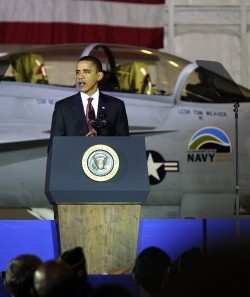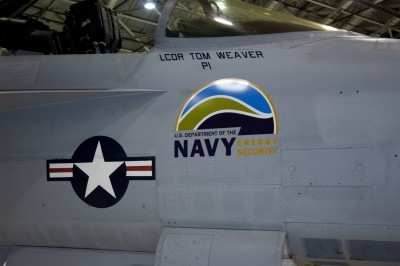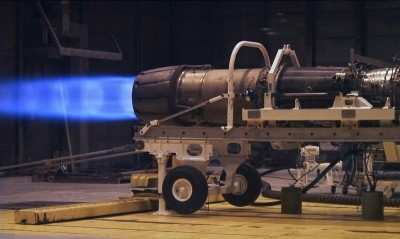Green Hornet To Take Flight On Earth Day
 President Barack Obama said Wednesday that his
administration's future plans on energy security to include the
Department of Navy's (DoN) biofuel program during a speech in
Hangar 3 at Joint Base Andrews, MD.
President Barack Obama said Wednesday that his
administration's future plans on energy security to include the
Department of Navy's (DoN) biofuel program during a speech in
Hangar 3 at Joint Base Andrews, MD.
These plans include strategic efforts by the Department of
Defense to enhance energy production and promote clean energy
innovation. As part of the Navy's Energy Strategy, the Navy is
developing the critical protocols needed to certify alternative
fuels for use in Naval Tactical systems.
During the president's announcement, an F/A-18 'Green' Hornet
and a Marine Corps Light Armored Vehicle (LAV) which are a part of
the DoN's biofuel program were in the background displaying
demonstrating progress toward the current administration's energy
goals.
"Our military leaders recognize the security imperative of
increasing the use of alternative fuels, decreasing energy use,
reducing our reliance on imported oil, making ourselves more
energy-efficient," said Obama. "That's why the Navy, led by
Secretary of the Navy Ray Mabus, who's here today, has set a goal
of using 50-percent alternative fuels in all planes, vehicles, and
ships in the next 10 years."
The Navy will demonstrate the 'Green Hornet,' an F/A-18 Super
Hornet powered by a 50/50 biofuel blend, on Earth Day, April 22, at
Naval Air Station Patuxent River, MD, as part of its Energy
Strategy.
Secretary of the Navy Ray Mabus has made energy independence a
top priority for the Department of the Navy (DoN), and the 'Green
Hornet' flight is an important step in the certification and
ultimate operational use of biofuels by the Navy and Marine
Corps.

The 'Green Hornet' initiative supports Mabus' energy reform
targets, which will increase warfighting capability by reducing
reliance on fossil fuels from unstable locations and reducing
volatility associated with long fuel supply transport lines. The
secretary's energy reform targets include:
By 2016, the Navy will sail a "Great Green Fleet" composed of
nuclear ships, surface combatants with hybrid electric power
systems using biofuel and aircraft flying on only biofuels. By
2020, at least half of the DoN's shore-based energy requirements
will come from alternative sources and half of total DoN energy
consumption will come from alternative sources.
"[The flight] will demonstrate that our systems can work on
biofuel," Mabus said in his remarks at a recent energy forum at the
Johns Hopkins Applied Physics Lab in Laurel, MD. "After it is
successful, and we are absolutely confident that it will be; we
will move to expand biofuel testing to our marine gas turbine
engines and to the engines of our tactical vehicles."
The biofuel blend to be used in the Super Hornet is derived from
the camelina sativa plant, which is a U.S.-grown, renewable,
non-food source. The objective of the Navy's biofuel test flight
program is to confirm there is no difference in performance between
the biofuel blend derived from the camelina plant and standard
petroleum-based JP-5. The Navy's ultimate goal is to develop
protocols to certify alternative fuels for use in Naval Tactical
systems.
The Navy Fuels Lab at NAVAIR Patuxent River, MD, will develop
certification requirements for a variety of biofuel sources,
including chemical properties, material compatibility, component
and propulsion system performance and weapon system
performance. The Defense Energy Support Center, which
oversees procurement of biofuel for the Navy, recently awarded a
$2.7 million contract to Sustainable Oils of Seattle and Bozeman,
MT. for 40,000 gallons of the camelina-based fuel.
Mabus, as well as energy and environmental leaders from
throughout the Department of the Navy, are scheduled be in
attendance at the Earth Day flight demonstration. Distinguished
visitors will have technical briefs and a tour before the flight
demonstration, and will meet the aircraft's pilot immediately
after. "We are a better Navy and a better Marine Corps for
innovation; we have led the world in the adoption of new energy
strategies in the past," Mabus said at the Naval Energy Forum last
year, when he announced his energy reform targets. "This is our
legacy."

Green Hornet is an environmental and energy concept that reaches
beyond the element of alternative fuels and encompasses efforts
ranging from operational and policy through technology research and
development. Examples of these efforts range from more energy
efficient aircraft refueling policies implemented by the fleet at
the Navy's master jet bases, to ongoing research and development
efforts by NAVAIR and General Electric to evaluate more fuel
efficient engine components. These engine improvements are designed
to reduce the Specific Fuel Consumption (SFC) for the F414
(F/A-18E/F Super Hornet) engine. The Super Hornet is Naval
Aviation's largest fuel consumer.
 ANN's Daily Aero-Linx (04.30.25)
ANN's Daily Aero-Linx (04.30.25) ANN FAQ: Turn On Post Notifications
ANN FAQ: Turn On Post Notifications Classic Aero-TV: Agile Aeros Jeff Greason--Disruptive Aerospace Innovations
Classic Aero-TV: Agile Aeros Jeff Greason--Disruptive Aerospace Innovations Aero-News: Quote of the Day (04.30.25)
Aero-News: Quote of the Day (04.30.25) ANN's Daily Aero-Term (04.30.25): Expedite
ANN's Daily Aero-Term (04.30.25): Expedite





